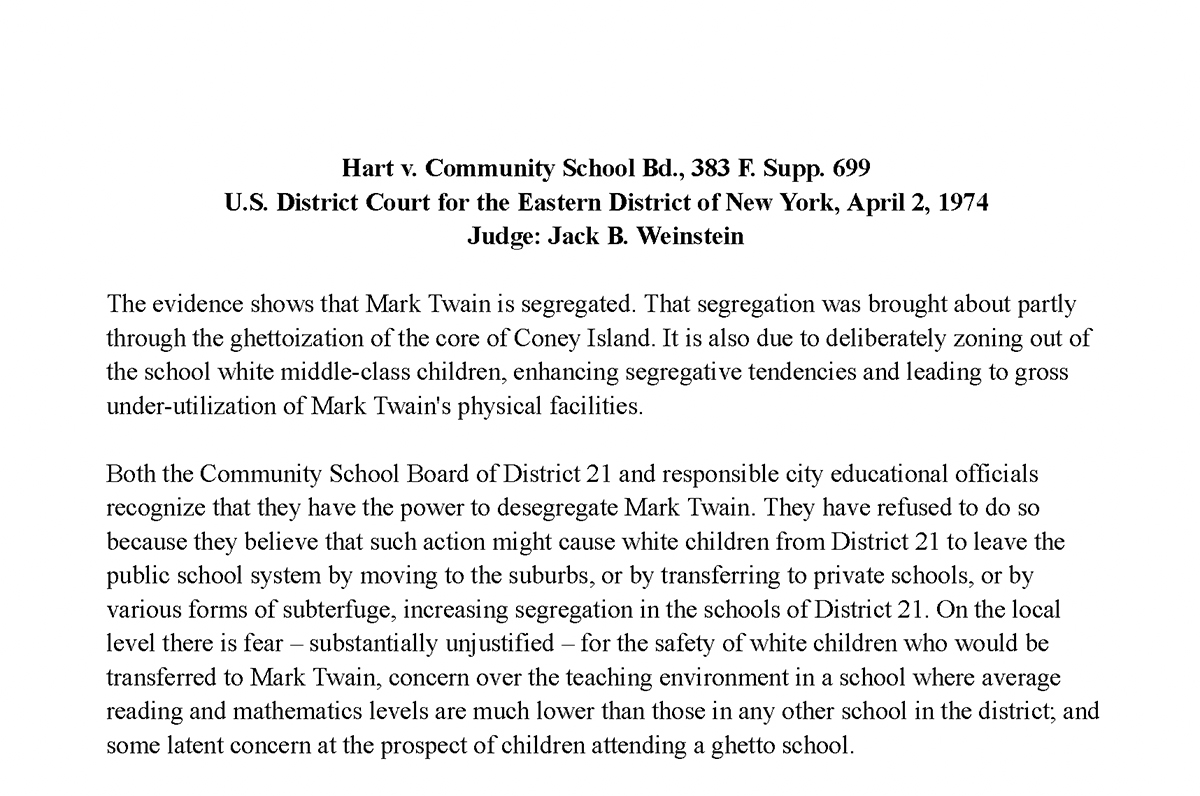You are here:
“Hart v. Community School Board 21, excerpt 2”

Date: Apr 2, 1974
Caption: In 1974, Judge Jack Weinstein ruled Mark Twain unconstitutionally segregated. In this excerpt he explains how he thought segregation at the school came to be.
Judge Jack Weinstein ruled Mark Twain unconstitutionally segregated in 1974. He identified actions taken by various public and private actors to segregate Mark Twain and the surrounding District 21 schools. He concluded that, “The evidence shows that Mark Twain is segregated … [partially] due to deliberately zoning out of the school white middle-class children, enhancing segregative tendencies and leading to gross under-utilization of Mark Twain’s physical facilities… Both the Community School Board of District 21 and responsible city educational officials recognize that they have the power to desegregate Mark Twain. They have refused to do so.”
Despite naming these actors and the policies used to segregate schools in District 21, the judge concluded that “racism was not a significant factor in what occurred in Coney Island.”
He also wrote about the terms “de jure” and “de facto” segregation. He described “de jure” segregation as typical of the US South and resulting from segregationist laws, and “de facto” segregation as the result of housing or private decisions. Judge Weinstein and many others used these terms in the 1970s, and some still do today. But as historian Matthew Delmont and others have made clear, “in every region of the country, neighborhood and school segregation flowed from intentional public policies, not from innocent private actions or free-market forces… the distinction between de jure segregation and de facto segregation [is] false.”1 When people in the North, like New Yorkers, used the “de facto” label, they were often seeking to avoid responsibility for creating and sustaining segregation.
-
Matthew Delmont, “The Myth of De Facto Segregation,” accessed April 8, 2024, http://whybusingfailed.com/anvc/why-busing-failed/the-myth-of-de-facto-segregation. ↩︎
Categories: Brooklyn, K-12 organizing
This item is part of "School Zones" in "How Did New York City Segregate its Schools?"
Item Details
Date: Apr 2, 1974
Creator: Hon. Jack Weinstein, US District Court for the Eastern District of New York
Source: Hart v. Community Sch. Bd. of Brooklyn, NY Sch. D. 21, 383 F. Supp. 699 (E.D.N.Y. 1974)
Copyright: Government Document
How to cite: “"Hart v. Community School Board 21, excerpt 2," Hon. Jack Weinstein, U.S. District Court for the Eastern District of New York, in New York City Civil Rights History Project, Accessed: [Month Day, Year], https://nyccivilrightshistory.org/gallery/hart-v-community-school-board-21-2."
Questions to Consider
- Why do you think Judge Weinstein says that “racism was not a factor” in segregating Mark Twain Junior High School? Do you agree, based on the evidence here? Who benefits from such a pronouncement? What problems does this kind of statement create?
- Have you learned about the terms “de facto” and “de jure” segregation in school? Based on what you have learned about segregation on Coney Island and at Mark Twain, is it correct to describe segregation in New York City as “de facto”?"
References
How to Print this Page
- Press Ctrl + P or Cmd + P to open the print dialogue window.
- Under settings, choose "display headers and footers" if you want to print page numbers and the web address.
- Embedded PDF files will not print as part of the page. For best printing results, download the PDF and print from Adobe Reader or Preview.
